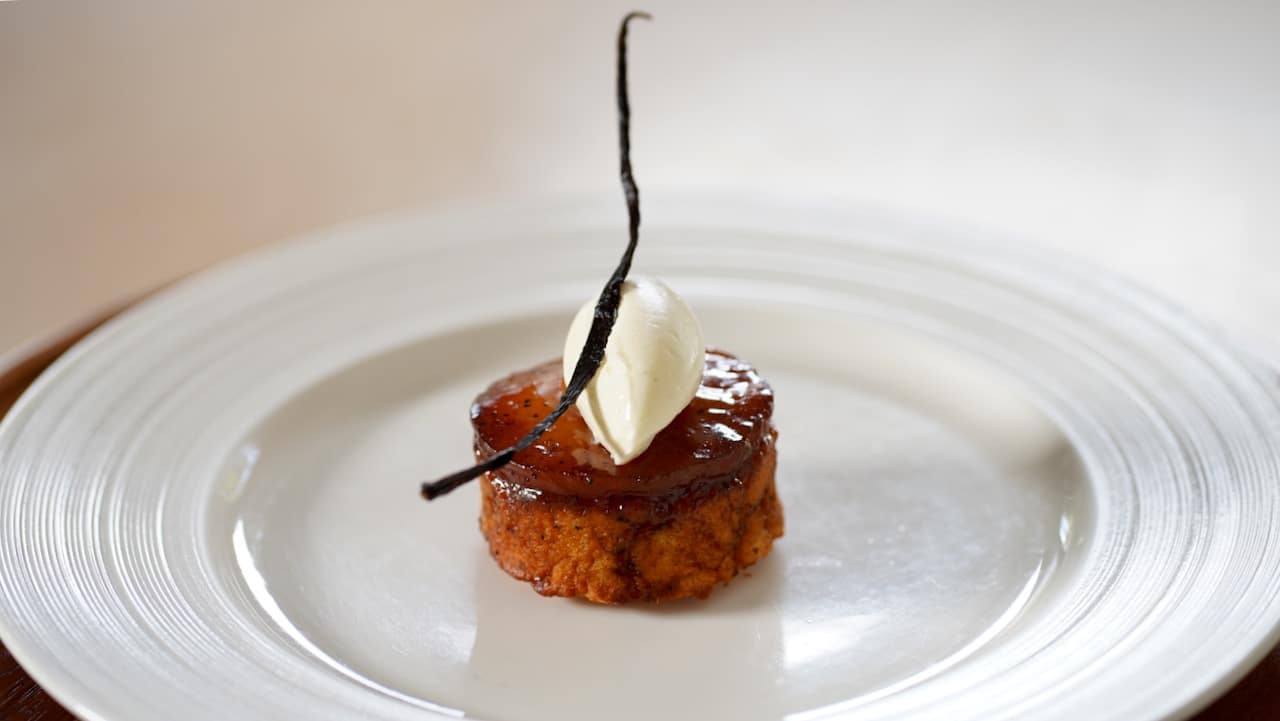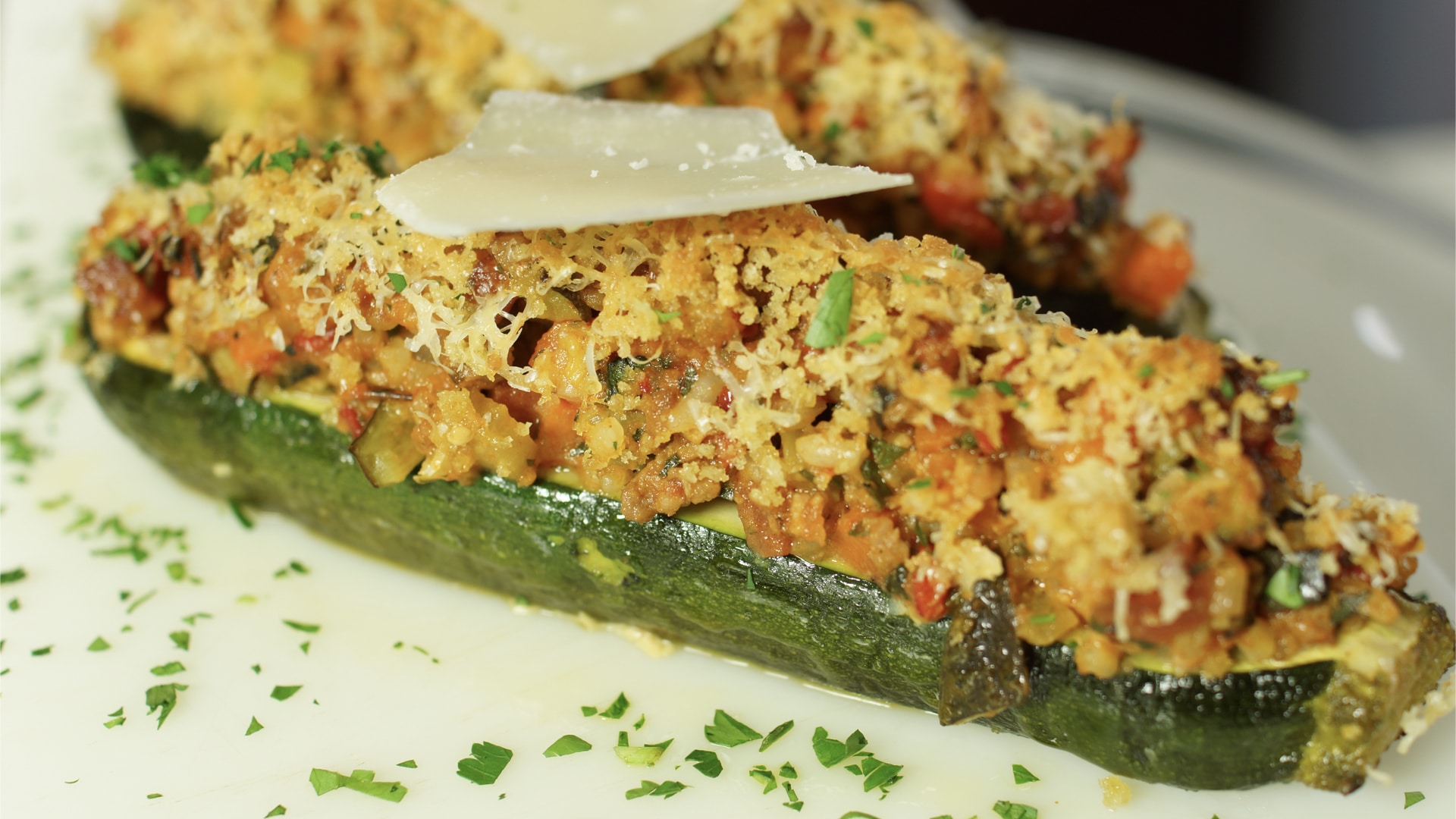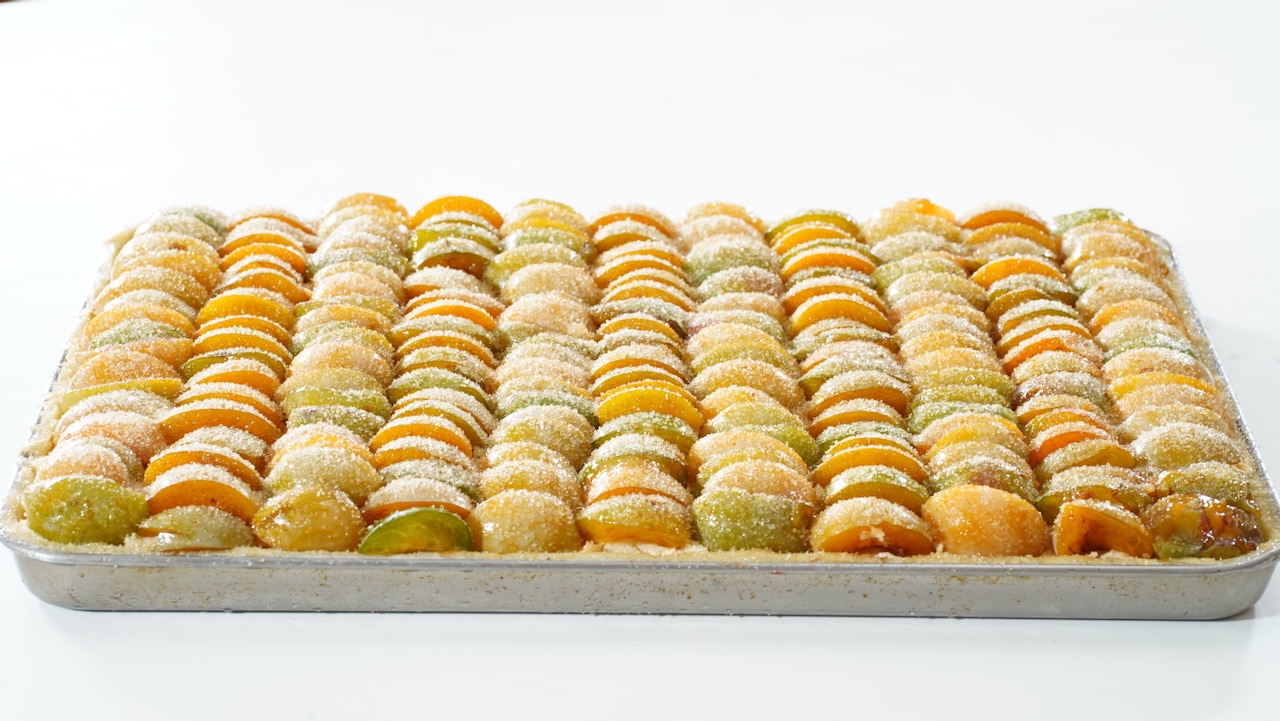Best Butter Croissant
The Secrets to Making Perfect Croissants. Croissants, especially the pure beurre or Parisian croissants, are the most revered breakfast pastries. Their delicate, flaky layers and buttery flavor make them a favorite around the world. In this comprehensive video tutorial, Chef Bruno Albouze will guide you through the intricate process of creating three beloved breakfast pastries: croissants, chocolate croissants (chocolatine) and pain aux raisins (escargot). Mastering the art of making these delicate and buttery pastries requires precision, patience, and a deep understanding of the techniques involved. Chef Bruno will share his expert tips and tricks to help you achieve perfect results every time. First, you will learn how to prepare the buttery laminated dough, essential for creating the flaky layers that define a classic croissant. Chef Bruno will demonstrate the proper folding and shaping techniques to ensure that your croissants have a light and airy texture with a crisp, golden exterior. Next, indulge in the decadent world of chocolate croissants, where rich chocolate meets buttery layers of pastry in a delightful marriage of flavors and textures. Finally, delve into the delightful realm of pain aux raisins, a whimsical pastry featuring swirls of dough studded with plump raisins and pastry cream. By the end of this tutorial, you will have the skills and confidence to recreate these iconic breakfast pastries in your own kitchen. Chef Bruno's expert guidance and clear explanations will empower you to elevate your pastry-making skills and impress your friends and family with these delectable treats.
Please note that the full access to this content needs a subscription: please sign up.
The most revered breakfast pastries
This recipe is a protected and only available for paid members. To obtain the full step by step recipe and detailed ingredients list, please sign up.
Preview the recipe
Before You Start
- Croissant dough requires a delicate balance of ingredients and environmental factors to achieve the perfect consistency and flavor. When preparing croissant dough, it's important to consider the impact of atmospheric pressure, humidity, and temperature on the dough. These factors can influence the fermentation process and the final texture of the croissants. To ensure optimal results, it is recommended to work in a kitchen with stable temperature. Furthermore, having enough free space in the freezer is essential when making croissant dough. Chilling the dough at various stages of the process is crucial to relax the gluten. Remember, the secret to a perfect croissant lies not only in the ingredients but also in the precision and care you put into every step of the process. Achieving the perfect temperature when working with croissant dough is crucial for obtaining those wonderfully flaky and buttery pastries we all love. The ideal temperature for mixing croissant dough should be around 70ºF/21ºC. The day after step is to laminate it, which involves incorporating layers of butter through a process of folding and rolling. For this step, the ideal temperature should be slightly lower, around 64ºF/18ºC. This lower temperature helps prevent the butter from softening up too quickly during the lamination process, and shaping.

- In a typical croissant recipe, you would use 1kg/2.2lb of flour to create a total dough weight of 1.9kg/4.2lb. When you add the butter block (500g), the total weight increases to 2400g/5.3lb. In a professional kitchen, skip the step of dividing the croissant dough after the first fermentation when using a dough sheeter/pastry sheeter. If you follow this recipe, you can expect to yield about 36 croissants, each weighing around 65g/2.2 ounces. However, keep in mind that you will lose some dough when cutting out the croissant shapes, resulting in about 32 items. While you could incorporate these scraps into the next batch of croissant dough, it is worth noting that they may affect the final proofing of the croissants. Instead of using the scraps and failed laminated croissant dough for more croissants, you can save and freeze them to make: Pissaladière Pizza or Galette Bresanne. This way, you can minimize waste while still creating a delightful treat. At home, whether you choose to make croissants by hand or using a stand mixer, one crucial step in the process is dividing the fermented croissant dough into two portions before laminating using 250g butter block for each dough. Each laminated croissant dough paton will produce 16 croissants (2X8).

Croissant Dough Matrix
- The Total Temperature Factor (TTF) also known as Basic Temperature ''temperature de base'' was determined by professional bakers to ensure consistent fermentation results every day. It takes into consideration the temperature of the fournil, lab or kitchen, the temperature of the dry main ingredient (flour), and the friction factor according to the machine in use. The liquid temperature is then adjusted in order. Yeasty doughs after mixing, should end up with an internal temperature of 77ºF/25ºC, which is known as desired dough temperature (DDT), this will ensure a proper fermentation process. If internal temperature reads 22/23ºC, leave the dough out for an hour, and then place in the refrigerator. If above 26ºC, place the dough in freezer in order to slow down the fermentation process. After 30 minutes spent in the freezer, transfer dough to the refrigerator. Therefore, kneading by hand or using a mixer or kneading machine will increase dough temperature by approximately 6 degrees celsius which is known as friction factor. Most croissant recipe calls for a TTF sets at 52ºC.For example: if the room temperature is at 22/23ºC and the flour is at 22/23ºC as well. The calculated liquid temperature is at 6ºC. 23+23+6=52. Take this fifty two number and divide it by three: 52÷3=17. Now, add the friction factor number to the equation: +6 degrees celsius. 17+6=23.5ºC/25ºC.Note that during the Winter season, the liquid shall be warmer; around 15ºC.

Which Butter To Choose For Croissant
- European-style butters are favored for their rich taste and saturated yellow hue — a direct result of the higher butterfat content 82/84%, and less water. The brand Kerrygold available in the U.S is a good choice. In France, we are fortunate to have access to a wide variety of high-quality butter such as: beurre d'Isigny, Le Gall, Président etc..
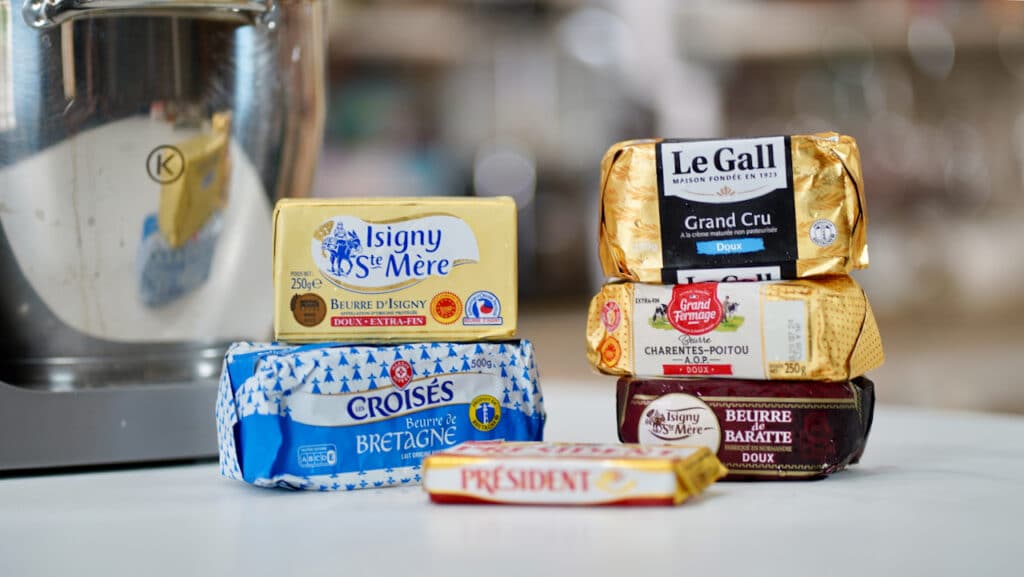
- In addition and among other brands, Elle & Vire offers extra dry butter (84% fat) into plates for professionnels. This increased fat content makes these butters richer in flavor and more supple, or able to bend while cold without breaking. When making croissants, the quality and handling of butter are crucial to achieving the desired flaky, layered texture. Avoid butter that has previously been frozen, it can develop a marbled appearance when incorporated into the dough. This marbling occurs because freezing can alter the butter's fat and water content distribution, leading to uneven layers.

What Flour To Choose For Croissant
- For a more manageable and ultimately superior croissant dough, consider incorporating a mixture of 1:1 ratio of bread and unbleached all-purpose flour. The key to this winning combination lies in the unique properties of each type of flour. Unbleached bread flour, with its higher protein content, adds structure and stability to the dough. On the other hand, unbleached all-purpose flour helps to create a lighter and more tender crumb in the final product, ensuring that your croissants maintain their shape and rise beautifully in the oven. By blending these two flours together, you strike the perfect balance between tenderness and structure, resulting in croissants that are delightfully flaky yet hold their shape beautifully. Additionally, this flour mixture is easier to work with, making the rolling out process a breeze and allowing you to achieve those perfect thin layers that are characteristic of a great croissant.
Egg Wash
- Mix eggs with the immersion blender. Keep refrigerated for up to 3 days.
Make The Butter Block
- This can be made ahead of time. Leave butter out for 2 hours to soften but not too much. In the mean time, mark a 6-inchX6-inch/15X15cm square in the middle of a piece of parchment paper or heavy plastic wrap and then flip over so the marked side is facedown. Place the room temp butter in the center of the marked square.

- Fold the parchment or plastic over to completely encase the butter. Flip and press down butter with the rolling pin to spread it out evenly. Keep refrigerated.
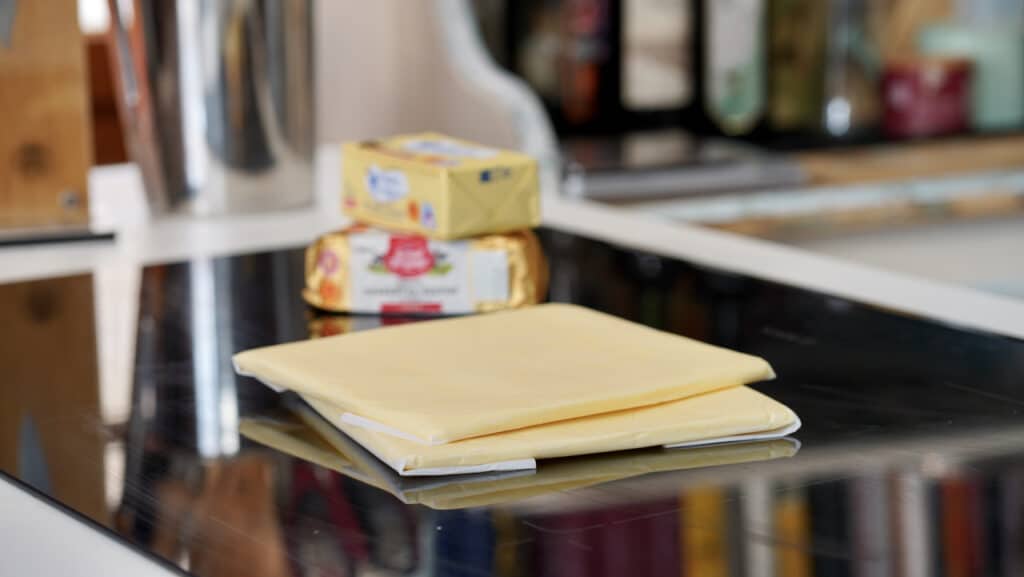
Croissant Dough
- At home, whether you prefer the tactile experience of kneading croissant dough by hand or the convenience of a stand mixer, the end result will be the same.

*Fresh Yeast vs Instant
- Fresh yeast and instant yeast are both commonly used in baking, but they have some key differences that can affect the outcome of your recipe. Fresh yeast, also known as compressed yeast or cake yeast, is made up of living yeast cells that are suspended in a moist slurry. It has a short shelf life and needs to be refrigerated to maintain its potency. Instant yeast does not need to be dissolved in liquid before mixing with the other ingredients, making it convenient and easy to use. If Using Fresh Yeast In Croissant Dough: Pour the liquid in the mixing bowl first, add yeast along with sugar and honey – stir with a whisk. Add flours, salt and room temp butter. If Using Instant Yeast In Croissant Dough: Divide the amount by two. Mix dry ingredients all together first. Add the butter and roughly sand the mixture. Pour in liquid and continue mixing until a cohesive dough forms.
Using The Stand Mixer
- Fit the stand mixer with the hook attachment. In the mixing bowl: stir water, milk, sugar, honey and fresh yeast with the whisk. Add flours, salt and butter. Mix on low speed for 5 minutes until it comes together.
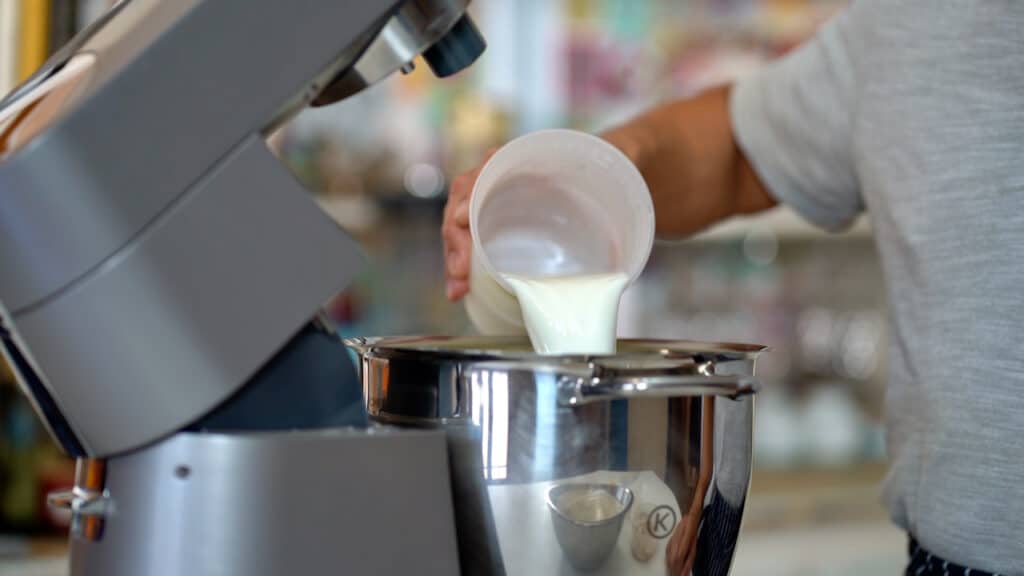
- Scrape down the sides of the mixing bowl twice during mixing.

- Increase mixer speed to medium-high, and mix for 6 minutes until the dough pulls away from the sides of the bowl. Do the windowpane test: Gently stretch a small portion of the dough into a square. Keep on stretching until it becomes a thin film in the middle without breaking. That means the gluten is well-developed and your dough is ready to rise. Transfer dough on the countertop without the use of any extra flour. Shape dough into a tight round and transfer to a lightly oiled pastry bowl. This helps prevent the dough from sticking and allows for easier removal later on.
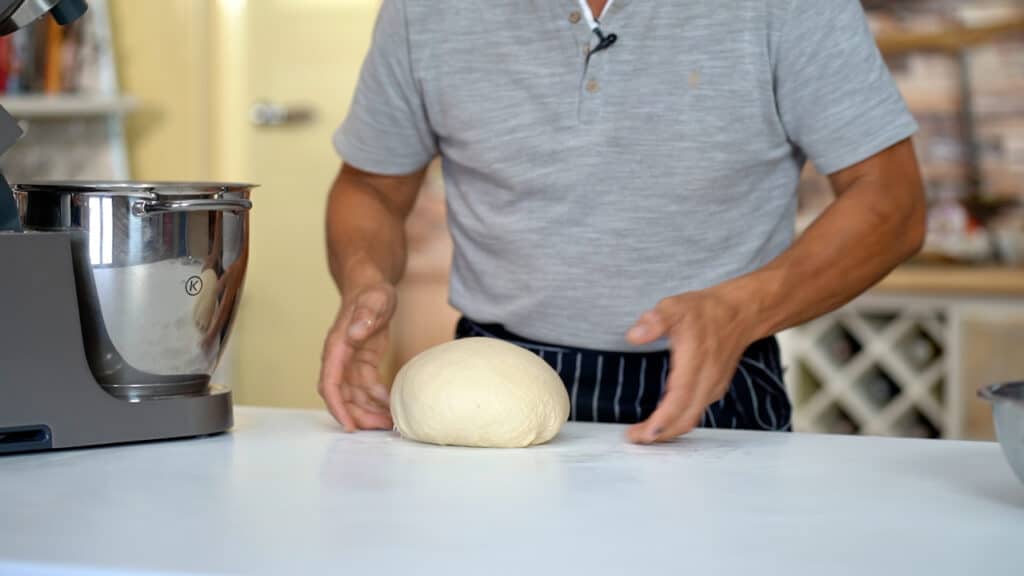
- Cover the container with plastic wrap to seal. Poke a hole in the center (this allows some of the carbon dioxyde to escape during the fermentation). Leave dough out for an hour, then refrigerator overnight. The slow fermentation process that occurs in the refrigerator enhances the taste and texture of the final baked goods. Additionally, the cold temperature helps control the yeast activity, leading to a more flavorful and tender dough.

- Place 2 baking trays in the freezer.

- Take the fermented croissant dough out of the refrigerator, and turn it out onto the work surface. No flour needed.

- Split dough into 2 equal portions.

- Deflate/degas dough, and shape into 2 tight ovales. Let rest 10 minutes.

- Flatten each ovale, and form 2 evenly distributed narrow rectangles.

- Place dough onto a frozen tray (seam side down), and freeze for 20 minutes; uncovered. Flip dough, and freeze for another 20 minutes. This step helps to firm up the dough, making it easier to laminate.

Laminating Process
- One of the key techniques in making croissants is the process of lamination, known as tourage in French. This technique involves layering butter between the dough to create those signature airy layers. The dough temperature should be around 36°F/2°C, and the butter block 53/59°F (12/15°C). Leave it out for about 5 minutes during the Summer season and 15 mins during the Winter. It should be malleable (like clay) but not soft.

Lock-in The Butter Block
- The lock-in is the initial encasing of the butter in the dough. Lightly flour the countertop. Readjust the cold and firm croissant dough to a 6X16 inch/15X40cm rectangle (about twice the length of the butter block). Keep refrigerated.

- Place butter on top of the dough, and fold over the butter, encasing it in dough. You may want to gently pinch the sides.

- Rotate to a quarter turn, and gently press down with the rolling pin.

- With a cutter, make a deep straight cut on each side. This trick helps the butter to get evenly distributed throughout the dough, and right from the beginning. Gently flatten and let rest in the refrigerator for 10 minutes before you give the turns.

Double Turn/Fold (Tour Double)
- Do not use the pasta machine yet to make the turns. Roll out dough into a long strip that should measure 6x27-inch/15X70cm. Keep all edges as straight as possible, starting rolling it out from the center of the dough towards the edges, and not from one side of the dough all the way to the other side. This technique helps to keep the dough at an even thickness. Do not hesitate to chill the dough 10 minutes or so to relax if it resists.

- Brush out any excess flour. Fold in approximately 1/6 of the dough from the left edge inward. Trim the ends if necessary, and redistribute the dough prior to fold.

- Bring the other edge of the dough to meet the folded edge. Then the right third is folded in. Roll out to seal.

- Then, fold this entire folded dough in half like you would a book.

- Roll out into a long and thick rectangle, and cover the dough with plastic film or parchment. Let rest in the refrigerator for 30 minutes. Resting croissant dough is a crucial step to ensure the dough relaxes and becomes easier to work with.

Single Turn (Tour Simple)
- Roll out dough into a 6x27-inch/15X70cm rectangle. Brush off remaining flour as often as it needs it.

- In order to create straight, clean edges, the edges may be trimmed prior folding.

- Then, the dough is folded in thirds, like a business letter.

- Flatten the laminated croissant dough into a 8.5-inch/22cm squared slab. Cover with plastic wrap, and place in the refrigerator an hour to rest.

If Using The Dough Sheeter
- By automating the process of rolling and folding the dough with the help of a dough sheeter can help you achieve consistent results with less manual labor. One of the key benefits of using a dough sheeter is the reduction of resting time required during the lamination process. As a result, you can bypass the resting time in between turns and proceed with the lamination process more efficiently. Proceed to make the double and single turn as explained above. Shaping croissants: Start by setting the sheeter to its widest setting to begin the rolling process. Gently feed the dough through the sheeter (seams set from noon to 6 o'clock) taking care to support the dough as it passes through. Keep the work surface lightly floured to prevent sticking. As the dough becomes thinner, gradually decrease the thickness setting on the sheeter and continue to pass the dough through until it reaches 5 millimeters thickness. Brush off excess flour. Cut into 32 croissants.

If Using A Pasta Machine
- Cut the laminated croissant dough paton into 2 equal portions otherwise it won't go through the machine.

- Flatten out dough into evenly distributed rectangles, place on frozen tray and freeze for 10/15 minutes before getting to the next step. Lightly dust flour over the pasta machine and dough. Roll out dough again so that it fits in the widest sitting of the rollers. Then towards the end, set the adjustment nob of the pasta machine at #9 to reach the final proper thickness: 5mm. Pass through the pasta machine twice. You should end up with a 8X18-inch/20X46cm rectangle. Brush off any remaining flour left on the surface and countertop.

Rolling Croissant Dough By Hand
- If rolling croissant by hand, one essential technique that should not be overlooked is the process of refrigerating the dough during and after folding. By taking the time to chill the dough at various stages, you are allowing the gluten to relax, which in turn makes it much easier to roll out the dough without it springing back.

Cutting Croissants
- Split the croissant dough sheet in half. Then make a lengthwise cut creating 4 equal rectangles.

- Rotate them upward. Make 2 triangles out of each rectangle make 8 croissants. Now, here's where things get interesting. Some pastry chefs choose to make an inch/2.5/3cm incisions from the base of each triangle before rolling them up to form croissants. This additional step increases the width of the croissant, resulting in a slightly different appearance. However, it's important to note that this may compromise the visual height of the croissant. Whether you choose to cut the base of the croissant triangles or not, the most important thing is to handle the dough with care and precision throughout the process.

Shaping Croissants
- With the base of the triangle held in one hand, elongate the dough by very gently stretching from the base and continuing all the way to the tip of the triangle. Starting at the base of the triangle, roll toward the tip. Press down the tip to seal the rolled croissant.

- Arrange croissants next to each other onto a frozen tray, egg wash and freeze. Freezing croissants overnight strengthen the gluten improving final results.

Chocolate Croissant/Chocolatine
- To make 12 chocolatine: Roll out croissant dough into a 7X20-inch/18X50cm rectangle. Make 3 cuts lengthwise, and share in 4 portions creating 12 rectangles.

- To make larger (8) chocolatine: Split croissant dough sheet in half.
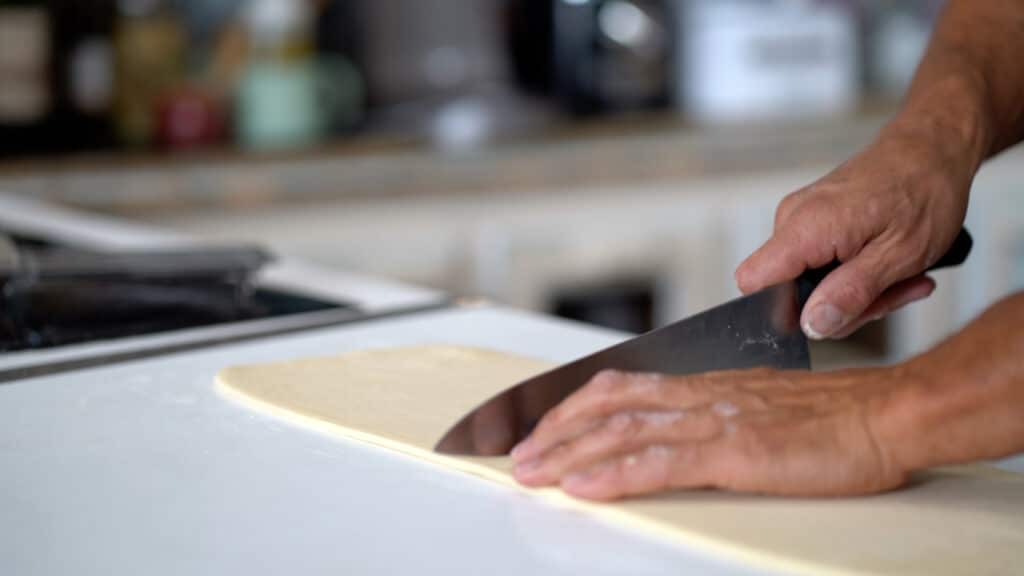
- Rotate dough upward, and cut dough sheet into 8 rectangles.

- Overlap about 7 chocolate disks or place 2 chocolate sticks on each.

- And roll into logs. Arrange chocolatine on a frozen baking tray. Repeat with remaining dough, egg wash and freeze.

Pain Aux Raisins
- Raisins soaked in either hot water or dark rum can be used in a variety of dishes, adding moisture and rich flavor. Here are a few suggestions:Drain prior to use. Apple Pies: Add plumped raisins to the apple filling for added sweetness and texture. Rum-Raisin Ice Cream: Mix rum-soaked raisins into the churned vanilla ice cream for a decadent treat. Bread Pudding: Incorporate the juicy raisins into your bread pudding mixture for bursts of flavor. Cakes and Muffins: Fold soaked raisins into batter for cakes or muffins to keep them moist and flavorful.

- Half of the croissant recipe produces 16 pain aux raisins.Beat the chilled custard before using. Roll out dough as explained above. Split croissant dough sheet in two. Spread custard evenly.

- Spread drained raisins and diced candied oranges evenly.

- Roll both croissant sheets into tight logs, and place in the freezer for 30 minutes. Cut each log into 8 portions.

- Arrange pain aux raisins on frozen tray and freeze. Once frozen, bag up and keep frozen for up to 10 days.

- For crispier pain aux raisins, have them proofed and and baked in buttered and raw sugared cake rings.

- Place frozen pain aux raisins in prepared cake rings, and let proof 2 to 3 hours. Bake as directed bellow.

Gum Arabic Syrup
- Gum Arabic is a natural sap from the Acacia tree. It dries to form a clear, hard, and brittle film that is less hygroscopic than pure sugar. Acting like a varnish, it is often utilized in the pastry industry to make coatings. It gives petits fours and other pastries a beautiful glossy finish. Combine water, lemon juice in a saucepan. Heat gently, and stir in gum Arabic powder until it dissolves. Add simple syrup, bring to a boil and cook 2 minutes. Give a quick mix using your immersion blender if needed. Strain through a fine-mesh sieve to remove any undissolved particles. Gum Arabic syrup can last a couple of weeks in the refrigerator, or kept frozen for months.

Proofing Method 1
- If you are lucky enough to have a controlled proofing cabinet in your kitchen, start by arranging your frozen croissants on trays. Place the trays in the proofing cabinet and set the dashboard computer according to your desired schedule. Otherwise, place six frozen croissants/chocolatine per baking sheet (do nine if croissants weight less than 55g each). Make sure the tip of the rolled croissant stays tucked under as it is placed on the pan. Let croissants thaw in the refrigerator overnight first, and then place in the warm place that should not exceed ≈78ºF/26ºC. Let proof for 2 hours or until croissants have doubled. Egg wash with care and bake.

Proofing Method 2
- Arrange frozen croissants on frozen baking trays. Let them proof at room temperature for approximately 6 hours. Controlled proofing cabinets. One common method for proofing croissants is to cover them loosely with a sheet of lightly greased plastic wrap. The plastic wrap helps to create a warm and humid environment around the croissants during its slow defrosting phase. Covering croissant with plastic wrap during proofing remains optional though. Egg wash and bake.
Baking Croissant
- Two trays of croissants can be placed in the oven at the same time. Preheat fan oven to 350ºF/180ºC. If using conventional oven, set it to 400ºF/205ºC. Bake your croissants for 20 minutes. Rotate the trays halfway through the baking process. This simple step helps to ensure that all the croissants bake evenly, with a uniform golden brown color on all sides. Note that croissants are at their best about an hour after coming out of the oven. During this time, the flavors fully develop and the texture reaches its peak flakiness.

Glazing Croissant (optional)
- Lightly brush croissants with the hot gum Arabic syrup straight from the oven.

A Guide to Freezing Croissants
- Unbaked croissants and any other goods made with croissant dough can be frozen for up to two weeks. This allows you to prepare a batch ahead of time and have them ready to bake whenever the craving strikes. However, keep in mind that after about 10 days in the freezer, the yeast in the croissants begins to lose its effectiveness, which can impact the final rise and texture. For croissants that will be stored in the freezer for up to three months, add 40% more yeast to the recipe.
The Best Way to Keep Baked Croissants Fresh
- When it comes to freezing food, timing is crucial. Whether you are storing leftovers, fresh meat, fish, or even baked goods like croissants, it's essential to freeze them as soon as possible. For items like baked croissants, this should be done within 2 hours of baking to preserve freshness and flavor.When you're ready to enjoy your frozen croissants, preheat your oven to 400ºF (200ºC). Once the oven is hot, turn it off and place the frozen croissants on a tray inside. After 5 minutes, remove them and let them sit for 10 minutes or more before serving. This method helps to revive their flaky texture and buttery flavor.However, if croissants are not frozen, their shelf life is very short. So, what can you do with stale croissants? Almond Croissants!

Bicolor Croissant
- The art of making Bicolor Croissants is a delightful and elegant process that will elevate your baking skills to the next level. These croissants are not only visually stunning with their brown stripes, but they also offer a unique and sophisticated twist on a classic pastry. To achieve the perfect Bicolor Croissant, attention to detail is key. The secret lies in creating thin, delicate colored layers that harmonize beautifully with the buttery flakiness of the croissant. Enjoy!

Ready to discover this recipe? You're only 1 step away.
This recipe is only accessible to registered members!
Create your account to access all recipes and content of my website.
Join us now and enjoy more 800 recipes (Mostly French with European Influences, American Classics and Asian fusion)
Already register? Sign in
You might also like these contents...
Enjoy these free access recipes
Breakfast
Cronut
Entrees
How To Cut Potato Gratin
Cooking techniques
Deboning A Turkey Leg
Entrees
Rustic Ratatouille
Daily summer Recipe
Plum Slab Pie
Free Recipes
Chocolate Sauce
Free Recipes
Apricot Sablé Breton
Desserts
Sundae Ice Cream
Free Recipes
How To Decorate Ice Cream Cones
Free Recipes
Tapenade
Amuse Bouche
Zucchini-Basil Gazpacho
Free Recipes



